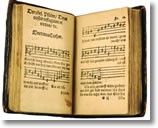by Dr. Albert B. Collver
As a boy I remember celebrating our bicentennial in 1976. Everyone was proud to be an American, or so it seemed to a child. All across the nation were decorations of red, white, and blue.
Fireworks lit up the night sky and parades rolled down the streets of cities and towns during the day. People had renewed interest in the founding fathers, and there was talk of freedom and liberty. Churches offered prayers for the nation, and pastors spoke with thankfulness on how the Lord had blessed America. When the “Star Spangled Banner” played, people were proud, and some were brought to tears. This was America’s song of independence, full of pride and hope.
I also remember being in church in October 1976 as the organ played “A Mighty Fortress Is Our God.” The procession marched down the aisle with the cross in front. The pastors wore robes with scarlet stoles. The entire congregation roared with lusty singing. What a moment! How proud I was to be a Lutheran on Reformation Day. When I sang “A Mighty Fortress Is Our God,” I felt as if I were thumbing my nose at the devil, the world, and all enemies of the Church. This hymn was the song of the Reformation, full of hope and pride.
Yet, is there more to this great hymn than I imagined at the time?
Seeking comfort in distress

Many people today think of “A Mighty Fortress” as the “Battle Hymn of the Reformation.” It is one of the most translated hymns in the history of the Church, having been translated into more than 200 languages. What many of us might not realize is that the Festival of the Reformation was not celebrated during Luther’s lifetime.
Therefore, the hymn was not written to celebrate the Reformation, which is the commemoration of the publication of the Ninety-five Theses on Oct. 31, 1517. Only later, after the Thirty Years’ War (1618–48), when the Reformation was celebrated as a regular part of the church year in Saxony, Luther’s home region, did the hymn become associated with the festival.
Considering that “A Mighty Fortress” is Luther’s most famous hymn, we know remarkably little about it. Nor are we even sure when Luther wrote it. The earliest existing hymnal in which it appears is from 1533. (From the records of 19th-century hymnologists we know that there were a few hymnals that contained “A Mighty Fortress” before 1533, but these hymnals were destroyed in the bombing of Dresden during World War II.) Most scholars think Luther wrote the hymn between 1521 and 1529, with the majority of scholars settling on 1527–28.
These years were some of the darkest in Luther’s life. A heading from a broadsheet (something akin to modern “sheet music”) of “A Mighty Fortress” published in Augsburg in 1529 reads “A Hymn of Comfort.” Rather than a battle hymn, Luther intended this hymn, based on Psalm 46, to be one of comfort. While we are not certain what prompted Luther to write the hymn, scholars have suggested a number of events during these dark years.
In August 1527, a man who followed Luther’s teaching was martyred. In the fall of 1527, a plague broke out in Wittenberg. In December 1527, Luther wrote to a colleague: “We are all in good health except for Luther himself, who is physically well, but outwardly the whole world and inwardly the devil and all his angels are making him suffer.” A few days later, in January 1528, Luther wrote that he was undergoing a period of temptation that was the worst he had experienced in his life.
When Luther speaks of “temptation,” he uses the German word. While Anfechtung is translated “temptation” or “trial,” it refers to anything that causes anxiety, doubt, fear, suffering, or terror in a person’s life. For instance, in December 1527, Luther’s daughter, Elizabeth, was born sickly. In May 1528, she died. The six months of wrestling with the Lord in prayer to save his sick daughter was a period of temptation (Anfechtung) for Luther. He was mentally and spiritually fatigued. He was under the cross of suffering. Yet, he took comfort in the Psalms and trusted in the promises of Jesus.
Struggles in the Church
Besides the challenges brought on by the plague and tragedy in his personal life, struggles abounded in the Church. From 1517 to 1525, most of Luther’s focus was on abuses within the Roman church. From 1525 onward, the struggles came from multiple fronts. Luther felt that his family, reputation, and work for the Reformation—that his entire existence—was at stake.
Because of its association with Reformation Day, many people not only think of “A Mighty Fortress” as the “Battle Hymn of the Reformation,” but also as a battle cry against the pope and Rome. Yet, when Luther likely wrote the hymn, his greatest challenge arose from other groups that had broken away from Rome. There were people who claimed to follow the Bible (and Luther) who wanted to revolt against the government, something Luther did not approve of. Others questioned whether pastors were necessary; they believed anyone could proclaim the Word of God. Some doubted whether infants should be baptized. The greatest and most divisive controversy among the reformers also took place during these years—the Sacramentarian Controversy, that is, the fight over the Lord’s Supper.
For 1,500 years, the Church had understood and confessed that Jesus gave His true body and true blood to eat and to drink in Holy Communion. No one within the Church questioned this. After the Reformation began, various interpretations about the Lord’s Supper appeared. People argued that Jesus could not really mean what He said, and that the words, “This is My body . . . This is My blood” needed to be understood in a different way.
For instance, the Swiss reformer Zwingli argued that “is” did not mean “is” but rather “symbolized.” Others argued that it is impossible for Jesus to put His body and blood on many altars at the same time. Still others said that because Jesus’ body was in heaven, it could not be on earth, too. In total, several hundred different interpretations appeared, all denying that Jesus actually gave His body and blood to eat and to drink in the Lord’s Supper.
Luther saw this controversy as directly related to the proclamation of the Gospel. He believed that the literal words of Jesus needed to be confessed and defended.
In this controversy, Luther argued that there was nothing more true, certain, or powerful than the Word of God. Indeed, the Lord’s Word is a “mighty fortress.” In the battle between Luther and the Sacramentarians, the Lord’s Word was the “trusty shield” to defend against their error and the “weapon” used to fight against them. The evil foe was using deceit and “deep guile” to obscure the words of Jesus.
In stanza 3, the hymn says, “Though devils all the world should fill.” Luther truly believed he was living in the Last Days because the preaching of the Gospel—that we are justified by grace through faith—and the Scriptures were clearly taught, and controversy after controversy arose. The world seemed full of “devils” perverting the Lord’s teaching. The stanza concludes, “One little word can fell him.” In the case of the controversy over the Lord’s Supper, the little word that “can fell” the devil is “is” from the Lord’s words, “This is My body . . . This is My blood.”
The hymn concludes by confessing that the Word of the Lord will remain in the world even if people are not thankful for it. In Luther’s day, there was the very real danger that he could lose his life, all his possessions, his reputation, and his family. Nevertheless, he sings confidently that “our victory has been won; the Kingdom ours remaineth.” Luther’s hymn is one of comfort and hope in the midst of trial and temptation, and strife within the Church.
A Hymn That Unites

A few years ago, I visited Madagascar. A vibrant Lutheran church exists there numbering in the millions. We arrived in time for worship on the first Sunday in Lent. While we could not understand the words spoken, many parts of the service were familiar because the liturgy of our churches is similar. The Gospel reading for the first Sunday in Lent is the temptation of Jesus. After 40 days in the wilderness, Jesus was tempted in every way that you and I will ever be tempted. He was tempted to question and doubt the very promises of God.
In the midst of His temptation, Jesus “felled” the devil with one little Word. He called on the promises of God recorded in the Scriptures. Because Jesus defeated the devil’s temptations, we know that in Him we, too, will overcome the devil’s temptations and trials.
After this comforting Gospel lesson was read, we heard the melody of “A Mighty Fortress.” Here in Madagascar, thousands of miles from our churches in America, the Malagasy were singing this great hymn of comfort. Through a common liturgy, lectionary, and this famous hymn by Luther, Lutherans around the world were united in confessing how the Lord is our Mighty Fortress.
Although my understanding of this great hymn has changed since I was a boy, I still love to sing “A Mighty Fortress Is Our God” on Reformation Sunday. Now rather than being merely the “Battle Hymn of the Reformation,” the hymn is so much more for me. It is the great hymn of comfort in the midst of trial, suffering, and temptation.
This hymn reminds us how Martin Luther, and others, preached the truth in love in the face of many obstacles and hardship. Rather than finding a single event behind this hymn, we can see how the plague, the death of his child, the controversies in the church, and other struggles in his life caused Luther to cling to his Lord, who is the Mighty Fortress of all those who trust in Him.
Because of this, we can sing this great hymn of comfort, not only on Reformation, but also during Lent and whenever we are in need of comfort.
